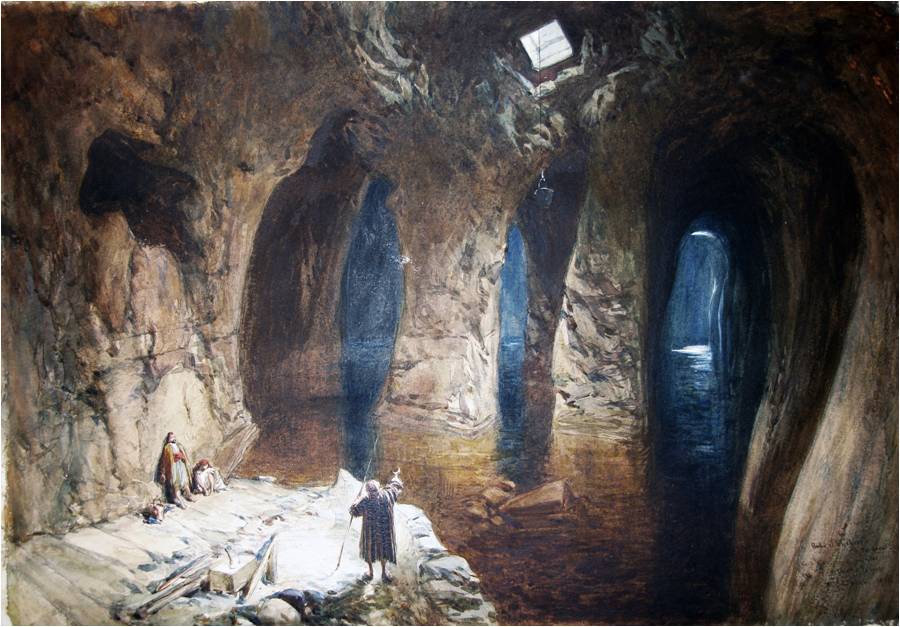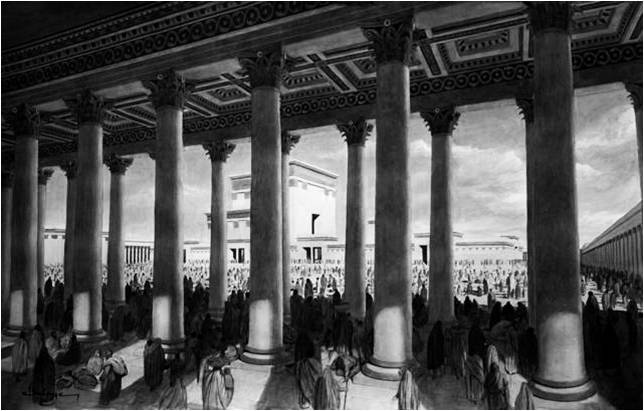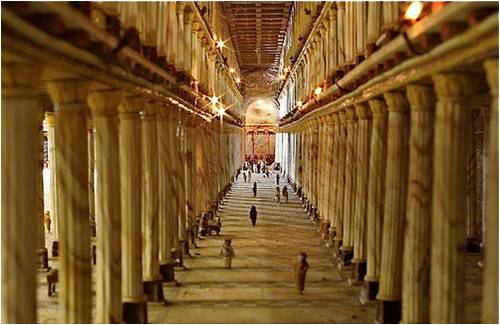Augustine commanded that Christians must actively purge from their consciousness the city of the flesh- Rome - and all its temptations to begin even to glimpse the heavenly city. In pursuit of this I traveled across North Africa, on to Turkey and Syria and later into Israel. And as I traveled I was forced to look further back and further forward and slowly the significance of Jerusalem and Temple Mount emerged. This would be the lens through which to look at the religious visions in reality.
See Also: Solomon's Temple: Myth, Conflict, and Faith (Wiley-Blackwell, 2012).
By Alan Balfour
Dean of the College of Architecture
Georgia Institute of Technology
January 2013
Before addressing the specific issues of the bible and its interpretation let me say a few words about method. My interest is in the metaphysical forces that shape our world, and in the desires and dreams they reveal, the pasts they are attempting to recover? We must be continually reminded of architecture’s full range and moral power, of its ability to illuminate and ennoble the human condition, to give expression to faith. The pursuit of such mysteries involves not just a journey in the flesh to experience and perform on multiple stages but journeys in the imagination in recreating the past.
Choosing a subject takes many months. I begin with a broad theme that seems relevant to these times. My method is to gather every available document - text, drawing, photograph, film, music that -through which to explore the content and significance of these shifting visions of reality, not only in their ideal state as built, but in as they age and in ruins.
My work on SOLOMON’S TEMPLE, Myth, Conflict and Faith began at the American Academy in Rome with very different objective, it was to explore the edges of Roman Empire as it was fading and Christianity was rising -essentially around the time of Augustine. The mystery for me was what effect did the move from the ‘city of the flesh’ - in Augustine’s words - to the desire for the City of God have on the construction of reality. Augustine commanded that Christians must actively purge from their consciousness the city of the flesh- Rome - and all its temptations to begin even to glimpse the heavenly city. In pursuit of this I traveled across North Africa, on to Turkey and Syria and later into Israel. And as I traveled I was forced to look further back and further forward and slowly the significance of Jerusalem and Temple Mount emerged. This would be the lens through which to look at the religious visions in reality.
Perhaps my most delightful and surprising day in preparing the work began at the British Library where by lunchtime I had gathered around me many of the extraordinary works exploring the idea of the Temple from the 17th-century onward. Among the more recent material there was mention of an organization called the Palestine Exploration Fund (PEF). And from the references this seemed like a worthy 19th-century aristocratic enterprise, a strange mixture of religion and historical curiosity. One reference implied that the organization still existed in some form. So I typed the name into my laptop and lo and behold there was a website with a brief history and an address off Marylebone High Street. This was but a short cab ride from the library so I set out on a sunny afternoon to search for 2 Hinde Mews, Marylebone Lane. It was exactly as you might expect from the address, a narrow Dickensian cul de sac enclosed by the backs of the 19th commercial structures that lined the main street. There I was met by a grim one-story building with tall windows heavily barred - forbidding save for a modest sign sticking out of the wall, PEF was all it said. This was No 2. I rang the bell and after some delay the door opened and I was looking up a short flight of stairs into a charming library: over the threshold and into a world unchanged since the 1920's and a sense that there was something secret and precious here. The PEF I learned has a history rich in associations with many of the outstanding names of Palestinian exploration, including Sir William Flinders Petrie, Sir Leonard Woolley and significantly T.E. Lawrence. All major documents that had both informed and resulted from the Funds decades long involvement with Jerusalem were here. By mid afternoon I had settled down to immerse myself in the extraordinary treasures that surrounded me. I began to relive the of 19th-century experience, uncovering and reimagining these expeditions inn Jerusalem. In the latter half of the 19th-century British power forced its way into Ottoman Palestine and the work of British surveyors, engineers and archeologists, produced what remains the most thorough survey and documentation of all aspects of Temple Mount: activity wholly forbidden to non Muslims for the last century. Most astonishing of all were the many drawings and details of the subterranean passages that lie beneath the Temple platform. Most dramatic of all the cistern – named the Great Sea - almost directly beneath the Dome of the Rock.

archives of the Palestine Exploration Fund. This lies beneath
the platform of Temple Mount between the al Aqsa Mosque
and the Dome of the Rock.
Myth: As the setting for such formative events in the history of faith it is inescapably became embellished by successive imaginations. In Judaism there lingers for a few the belief that somewhere deep below the surface of Temple Mount is the Arc of the Covenant hidden there in the midst of the war with the Babylonians in 586 BCE. But with the rock surface itself there was and remains a true mystery- the nature and significance of the Rock cavern that lies beneath the Dome.
It is first mentioned by the Pilgrim of Bordeaux, who journeyed to the Holy Land in 333 CE. He writes that on Temple Mount “are two statues of Hadrian and not far from the statues there is a bored-through stone, to which the Jews come every year and anoint it, and lament themselves with moans and tear their clothes, and thus depart.” The bored –through stone could conceivable have been the cavern that still lies beneath the Dome.
In Islam from the 9th-century onwards myths merged and reformed to speculate on the miraculous power of the Noble Sanctuary. There earliest collection of these is in the writings of Muqati Suleimani who died in 767. Most arise out of intensifying the experience of the faithful: A prayer said here was five hundred times more valuable than prayers said elsewhere. This was one of the few places where god permitted the creation of a building in his name and in which his unutterable name could be spoken. It was here that god lifted Jesus and Mohammed to Heaven. . This is where the first man, Adam, was created, and where he died. It is where Abraham was prepared to sacrifice his son Isaac and where his bones are interred.” And on and has faith forced imagination see the miraculous in every stone.”
However there is one splendid myth that could be reference to the cavern beneath the Dome: “As this Rock was the first land to appear above the waters after the flood, it was therefore closest to heaven. And its divine power would keep back the creatures of the apocalypse from getting to it.” A massacre decades ago has made entry into the Dome of the Rock highly restricted, but there is ample photographic evidence. It is impossible to offer a reasonable explanation for this pockmarked rock fissure, above which the imagination strains to see the Arc of the Covenant.
Conflict: With these myths in mind I spent many days exploring every accessible surface on the platform and in Herod’s great wall that surrounds Temple Mount. As I got to know each nook and cranny they revealed specific elements from biblical history. Then with constraint, I visited the Dome of the Rock, the Al Aqsa Mosque, (where I was politely asked to leave,) and as best I could I pried into the layers of ancient buildings that surround the precinct. Most satisfying for me was to discover that the marks of the columns that once held the great roof of Herod’s Royal Stoa were still evident. It was in this space that Christ is reported to have banished the moneychangers and only by being there can one begin to grasp the magnitude of the building.

Royal Stoa during Pesach. (c Balogh Belage Art
Resources New York.)
Herod’s masterwork - it was the largest inhabited structure in the Roman world. In extending the Temple platform to the south he build this portico –Stoa - this vast colonnade, a great open columned hall almost 700 feet in length, closed to the outside, but open within the Temple precinct to a new court - the Court of the Gentiles. A structure that not only sat opposite but in sense must have seemed to be in opposition to the Temple Sanctuary. Ahead was a forbidden place threatening death to any foreigner who dared enter, behind a vast welcoming hall of public assembly. The interior was formed from162 columns in three rows, each 50 feet high, they in turn carried an upper colonnade, which supported the wooden roof “adorned with deep sculptures, one hundred feet above the stone floor. “The thickness of each pillar was such, that three men might, with their arms extended, fathom it round, and join their hands again…Their (capitals) were made …after the Corinthian order, and caused an amazement by reason of the grandeur of the whole,” (Josephus). The al Aqsa Mosque now occupies the center of the space, but otherwise the space remains exactly as it was and several of the capitals still lie where the columns once stood.
It may be that its scale was simply an accommodation of the hundreds of thousands who attended the High Holy Days, but beyond this it must be asked to what grander purpose could such a vast place of assembly have been intended? It would have certainly satisfied, impressed, and perhaps encouraged the ambitions of those who admired the reason and free ways of the Hellenes. Given the bitter division that persisted in Jerusalem between those conservatives holding fast to their faith in the god of Abraham and Moses, and the many Jews who had sympathy for the beliefs and culture of the Greeks, the construction of the Court must have been seen as a political as well as a philosophical act and would have made many anxious.
Where in Temple ritual would there have been the need for such a massive accommodation of the Gentiles? Twenty thousand could easily have gathered within its enclosure. Was the Stoa shaped to actively encourage religious and political discussion? Was it Herod’s intent that conservative Jews, Philhellenic Jews, along with the Gentiles, might come together beneath these columns to share thoughts on the nature of god and faith? For more than two centuries, Jews had been profoundly touched by Greek philosophy not as something remote but something vital, an evolving presence within Judaic society. Herod’s support of Greek culture had renewed the debate on the relation between the beliefs and moral values of the Greeks and the Jews, with both sides trying to gain a deeper understanding of each other’s idea of god. Was it to help achieve this that he conceived of such a spectacular place?

(Photograph Geoff Robinson)
In 70 CE the temple the Stoa and every structure on Temple Mount was destroyed. This was the result increasing tension between the Jews of Jerusalem and the Roman occupiers it had been brooding for decades exacerbated by some oppressive administrations. Late in 66 CE, with the capricious Nero ruling the Empire, the Jews prepared for war with Rome. In 67 CE, the Roman General Vespasian with his son Titus arrived with a force of about 60,000 men and the war was fully engaged. In 70, a Roman army under Titus, on the orders of his father, Vespasian, now Emperor, laid siege to Jerusalem. The Romans moved from siege to the attack. The most remarkable aspect of what happens next is that a highly detailed account survives in the writing of Titus Flavius Josephus a Jewish general defending Jerusalem at the beginning of the the war he switched sides and appears to have entered Temple Mont with the invading Roman force. Blow by blow he recorded the actions that lead to total destruction. The Temple on fire: “the flame was also carried a long way, and made an echo, together with the groans of those that were slain; and because this hill was high and the works at the temple were very great, one would have thought the whole city had been on fire. Nor can one imagine any thing either greater or more terrible than this noise; for there was at once a shout of the Roman legions, who were marching all together, and a sad clamor of the seditious, who were now surrounded with fire and sword.…”
And after the conflict the Roman engineers went back into the ruins and systematically eradicated all structures from the Temple platform. Josephus again: “Now as soon as the army had no more people to slay or to plunder, because there remained none to be the objects of their fury, Caesar gave orders that they should now demolish the entire city and temple.”
Faith: In the Gospel of Mark (KJB Mark 12 1:43) records a conversation with Christ: “And as he went out of the temple, one of his disciples saith unto him, Master, see what manner of stones and what buildings are here! And Jesus answering said unto him, Seest thou these great buildings? there shall not be left one stone upon another, that shall not be thrown down.”
Mark is thought to be the earliest of the synoptic gospels written around the time of the Temples destruction and some have argued it would have been hard for the author to resist the claim that such a devastating event was foretold by this new religion. But why would Christ predict the destruction of the Temple? He may have been angry with the priests and their denial of his ministry. He may have been repulsed by the blind trust in animal sacrifice: his faith in Judaism did not need the sacrifice of countless numbers of animals to maintain the balance between man and sacred order. The death and resurrection of The King that cometh in the name of the Lord would be the ultimate, the final sacrifice. But to destroy temple would be to destroy the only place on earth where god had dwelled.
Mark is quite specific that the exchange took place as they were leaving the Temple precinct; leaving through the forecourt of the Stoa, and within this space or on the adjoining stairs it would have been the Stoa that dominated the view. Here were the “great buildings” adorned with “goodly stones and gifts.” Consider that it was the Stoa, not Solomon’s Temple that was the subject of Christ’s anger and his prediction. The Stoa, that vast stage of Hellenic theater had willfully or by chance encouraged Christ’s behavior and that of many others some who would be called false prophets. More than stage or market place the Stoa had become a forceful social instrument comingling the worldviews of Judaism and Hellenism. It had to be destroyed.
Comments (1)
Is there any reason to think that non-Jewish ideologies were expounded in the Stoa? There had to be a place where non-Jewish visitors could arrange for sacrifices to be offered - this would go with the Gospels critiique of the place of money in the Temple. There is also the theme of 'Jerusalem that kills the prophets' which seems to imply some degree of pollution of the Temple itself.
#1 - Martin - 02/10/2013 - 17:49
